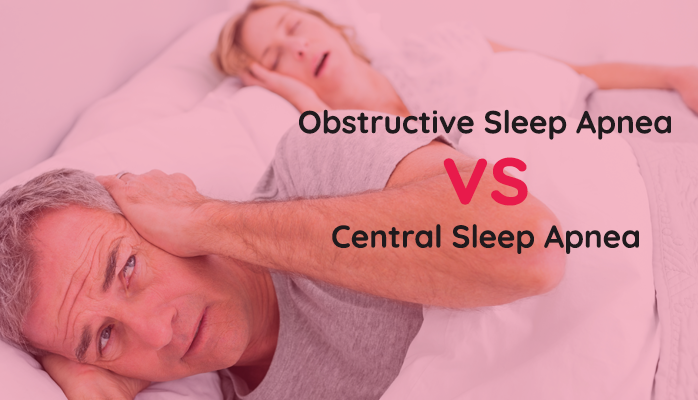What are the Types of Sleep Apnea
Sleep apnea (root meaning: "sleep" + "breathless") is a medical sleep disorder where you stop breathing for short periods (10 seconds or longer) throughout the night. When you stop breathing, your brain eventually rouses your body and you wake up. The point? You get a poor nights "rest" because you wake up many times during the night to prevent yourself from the self fulfilling prophecy of not breathing.
There are three types of sleep apnea, and two causes:
- (most common) Obstructive sleep apnea (OSA): there is a physical obstruction that blocks the airway
- (uncommon) Central sleep apnea: electrical malfunction in the brain causes you to stop breathing
- (rare) Complex sleep apnea: a mix of both central and obstructive sleep apnea
These sleep apneas have many negative side effects, most notably:
- General loss of performance in all life activities
- Lower life expectancy
- Correlations with diabetes and obesity
- Chronic irritation, depression, anxiety, and low stress management threshold
Let's look at obstructive sleep apnea vs. central sleep apnea in more detail.
What is Obstructive Sleep Apnea
Obstructive sleep apnea is the most common type of sleep apnea. It is caused when something obstructs your breathing airway, namely when the muscles in the back of your throat relax and causes the back of your tongue to press up against the back of your pallet. In fact, you can even simulate this if you try and relax the back of your tongue, press it up against the back of your throat, and breath in.
Symptoms of OSA
 In general, OSA is accompanied by loud snoring and if much more common in men. Many wives whose husbands have OSA might tell you that before treatment they could sit in bed and count the seconds between the time their husband stopped and started breathing again. If sounds familiar, a doctor visit is probably a very good idea. Other symptoms include:
In general, OSA is accompanied by loud snoring and if much more common in men. Many wives whose husbands have OSA might tell you that before treatment they could sit in bed and count the seconds between the time their husband stopped and started breathing again. If sounds familiar, a doctor visit is probably a very good idea. Other symptoms include:
- Chronic daytime fatigue or drowsiness
- Headaches in the morning
- Depression
- Chronic irritability
- Low stress management
- Feeling excessively sleep in the morning
- Impotence
- Brain fog
- Anxiety
There are others, as you can see in the image to the right.
Risk Factors for OSA
The following are key factors that can cause contribute to OSA:
- Weight - high body weight is directly linked to sleep apnea because it narrows the throat canal
- Diabetes
- Genetic factors - biological factors can also contribute/cause sleep apnea
- Alcohol use - alcohol relaxes the muscles in the body and can exacerbate OSA
- Smoking - smoking is an irritant and can cause inflammation that contributes to OSA
Treatment of OSA
Like central and common sleep apneas, obstructive sleep apneas is often treated with BiPAP and CPAP machines, though surgery and oral appliances are also sometimes used depending on the treatment course recommended by your doctor.
What is Central Sleep Apnea (CSA)
Central sleep apnea is also a sleep disorder where you stop breathing at night because the brain doesn't send proper signals to the muscles that control your breathing. This is contrasted with obstructive sleep apnea, which is caused by an actual physical obstruction (i.e., tongue/throat/tonsils).
Symptoms of CSA
Unlike OSA, where snoring may be present with central sleep apnea it is unlikely to be as prevalent as with obstructive sleep apnea. However, intermittent pauses during sleep are a key indicator in sleep apnea.Other symptoms are similar to OSA and include:
- Chronic daytime fatigue or drowsiness
- Headaches in the morning
- Depression
- Chronic irritability
- Low stress management
- Feeling excessively sleep in the morning
Risk Factors for CSA
There also may be underlying conditions that cause this type of sleep apnea, such as:
- Heart failure
- Stroke
- Drugs/medications
- Cheyne-Stokes breathing
- Parkinson's disease
Treatment for CSA
Usually, diagnosing and treating underlying conditions is the first step for treating CSA. If such intervention does not effectively treat CSA, then CPAP and BiPAP machines are extremely popular choices for CSA treatment.
Diagnosing Sleep Apnea
Fortunately, identifying and diagnosing these sleep apneas is straightforward. Your doctor may give you a referral to spend the night at a sleep center (often covered by insurance), where you will be evaluated with a scale (called apnea-hypopnea index or AHI) that will help your doctor aid in diagnoses:
- Mild sleep apnea: 5-14 sleep apnea events per hour
- Moderate sleep apnea: 15 to 29 sleep apneaevents per hour
- Severe sleep apnea: 30+ sleep apnea events per hour
Unfortunately, while it is called "mild sleep apnea", it still involves waking up at least dozens of times per night and still comes with the same risks and consequences of severe sleep apnea. Fortunately, CPAP or BiPAP therapy effectively treat sleap apnea.
If you live in Alaska, you can easily click below to get started with a free consultation with one of our sleep specialists - it should only take about 15 minutes.


